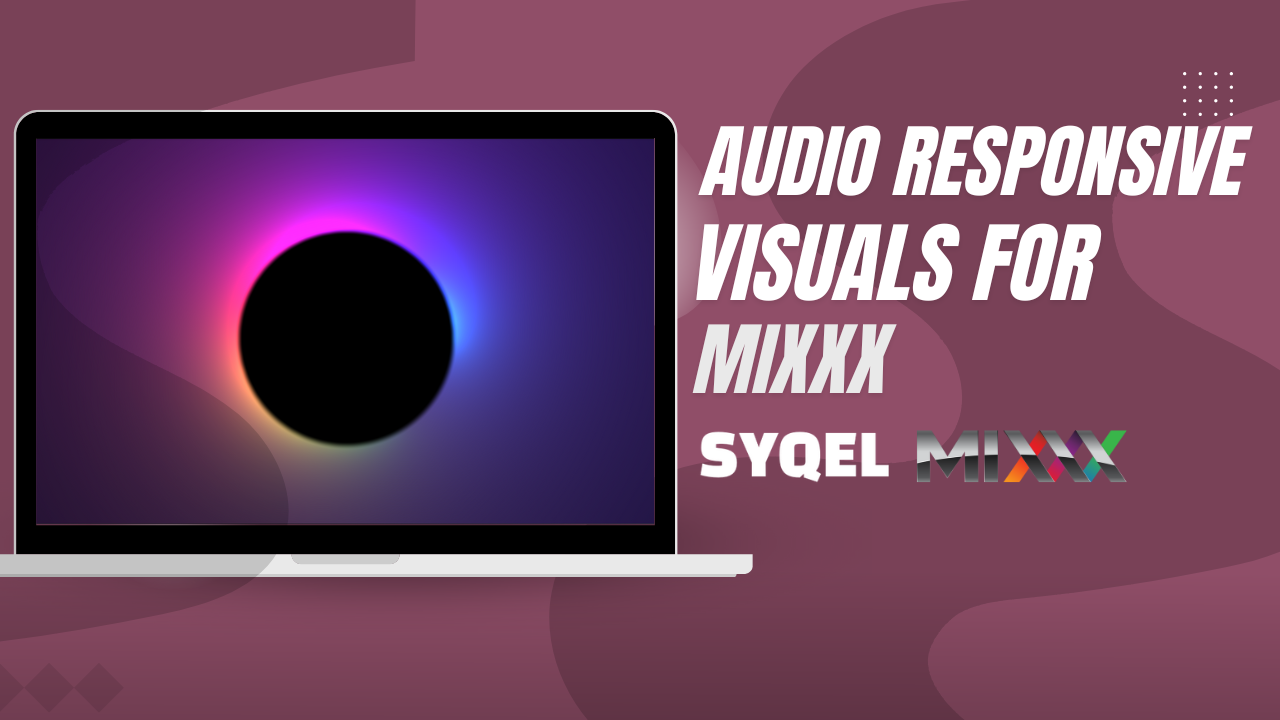Streamers and content creators alike are always looking for new ways to increase their audience and grab viewers attention. A great solution for widening your reach is using Restream to stream content to multiple platforms at once. Another amazing way to increase view time and keep viewers attention is visualizing your audio. We can do this easily with SYQEL. Together, Restream and SYQEL are powerful tools to level up your podcasts, streams, and content creation. Let’s go over, step by step, how to set up Restream and SYQEL with OBS.
Supplies
You’ll only need a few things.
1) A computer
2) OBS Software
3) Google Chrome and a SYQEL account
4) (Optional) (Windows Only) Virtual Audio Cable
5) (Mac Only) LoopBack Audio
6) Restream Account
Step 1: Setting up Restream
If you have never used Restream before, it is pretty simple. Create an account at Restream.io. Then, within the home-screen, add all of your social media accounts that you would like to stream to.

Now, with all of your accounts connected, head over to OBS and navigate to your settings.

Within your settings, head to the “Stream” section and select “Restream.io” under the service column. Connect your account.

Once you hit apply, you will see Restream pop up on OBS. You are now connected! Whenever you decide to stream, your content will be broadcasted to all of your connected accounts.
Now let’s go into how to get mesmerizing audio visuals that react instantly to your voice or desktop audio. Then we will go into how to screen record SYQEL in OBS so it can be included when you go live with Restream.
Step 2: Signing up for SYQEL
First and foremost, we need to create a SYQEL account. Head over to syqel.com to get started and create a free account.

Once you do, you will be greeted with the main page. SYQEL runs off your browser, so you don’t need to download anything.
Step 3: Selecting Your Visual Engine
SYQEL offers two different visualizer engines shown on the left-hand menu. The first is Three.js, which allows you to hand-pick pre-made visuals. The second is called Milkdrop, which cycles through hundreds of thousands of visuals automatically.

Today we’ll be using Three.js, so we’ll be able to pick out our visuals.
To do so, click on the settings button in the top right menu.
Step 4: Picking Out Your Visuals

Once you click on the settings icon, you’ll be greeted with the settings page.
This is where you can create a new visual playlist.
1: Name a playlist or select an existing one.
2: Then, click on available visuals. Here you can scroll and see all the pre-made visuals you can use in your playlist.
3: When hovering over a visual it will animate to your microphone input.
4: Once you find a visual you like, simply click on it and it will automatically be added to your playlist.
Playlists automatically save any changes you make!

5. Next, head over to the selected visuals tab.

6. Here you can remove any visuals by clicking the small “x” on the top left of each visual or click and drag your visuals into whatever order you would like them displayed.
Step 5: Upload Your Watermarks

Next, head over to the watermarks section of the settings page.
1: You can upload up to 9 watermarks.
2: Choose their size and positioning.
3: Don’t forget to save your watermark settings at the bottom of the page!
You will be able to cycle through these once you have your visualizer started, so you don’t have to stop the visualizer to switch through your watermarks.
Step 6: Setting Up Frequency Reactiveness

This is an optional step!
If you would like to create different frequency reactiveness templates, for different styles of music, this is a very powerful tool to use!
To start click on the frequency reactiveness section of the settings page
This will determine how your visualizer reacts to the audio. If you only want the kick and bass to affect your visuals, you can set that here. You can save your settings as an audio preset, which we can then choose when we set up our visualizer engine.
Step 7: Setting Your Visualizer’s Behavior
Click on the visualizer behavior section of the settings page. You will see three options.

1: The framerate of your visuals. You can set this up to 244 frames per second.
2: How many seconds each visual lasts on screen before it cycles to the next visual in your playlist.
3: How long the transition is to each visual.
Make sure you save your settings at the bottom!
Step 8: Setting Up Your Visual Engine

Now you’ve created your first playlist and set your visuals frequency reactiveness and behavior. Our visuals are ready to go, we just need to set up our visualizer engine.
First, let’s click on Three.js in the left-hand menu of SYQEL. You will then see 3 drop-down menus appear.
1: First is your audio input which we will go over in the next step.
2: Second, you have your playlist selection.
3: Third, your audio preset selection.
Let’s go over how to set up SYQEL to receive audio from your microphone or desktop audio.
Step 9: Routing Your Microphone or Desktop Audio to SYQEL (Windows)

There are two main ways to route desktop audio into SYQEL.
1: First, if you are using Realtek Desktop Audio, that will show up here in the drop-down menu.
2: We can use a Virtual Audio Cable to get specific audio sources routed into SYQEL
Your microphone audio will automatically show up under SYQEL’s audio input. If you do not see your microphone audio as a selection, make sure it is shown in your audio settings on windows under the input section.

Step 10: Virtual Audio Cable (windows)
Download a virtual audio cable. They are easy to obtain, free, and open source.

Download HERE
Once you have your cable installed (virtually!), in whichever program you wasnt to visualize are using select “virtual audio INPUT” or “Line 1” as your audio output. And within SYQEL, your audio will show up as “virtual audio OUTPUT” or “Line 1” under SYQEL’s audio selection.
We are almost ready to visualize our music.
Step 11: Select Your Playlist, Audio Input, and Audio Preset in SYQEL (Windows)
Back in SYQEL, we need to select our parameters in our drop down menu.

1: Select “Line 1” Virtual audio cable as your input. (Or virtual audio cable OUTPUT)
2: Then, select the playlist you created earlier.
3: Finally, if you saved any audio presets in the frequency reactiveness menu, select those here as well.
Before we start our visualizer, let’s go over how to route your audio on MacOS.
Step 12: Setting Your Audio Source (MAC)
For users who are on Mac the process is much simpler. We just need to download Loopback.
Loopback is an audio device that allows users on MAC to route their internal audio. Simply download loopback and install it. The process is much simpler. Create a new audio device within Loopback, and you are all set! Your audio device will show up under SYQEL’s audio selection.
We are ready to start visualizing!
Step 13: Start Your Visualizer

Once you have all three of your parameters selected, hit the Start Visualizer button to immediately begin the visualization.
The visualizer will start reacting to your audio as soon as any audio is playing from your selected audio source. Simply hit Stop Visualizer to stop the visualization.

Let’s go over how to connect your visuals to OBS.
Step 14: Streaming SYQEL With OBS

1:Launch OBS and create a new window capture source.


2: Select Window Capture.
3: Have Google Chrome be the source! You should see SYQEL in your new window source.
4: From here you can re-size SYQEL’s window!
Step 15: Go Fullscreen

Back in SYQEL we can go full-screen.
1: Hide the toolbar by pressing the hotkey “h”.
2: Click the full screen button at the top right.
3: Navigate to the top left and hit the menu button.
You are now fullscreen! OBS will be able to capture your visual full screen without any cropping.
Now, we can start recording or streaming.
Step 16: Record Your Set / Stream your Set!

Now, with your visual is started, and OBS is capturing SYQEL, we can hit the Start Recording or Start Streaming button in OBS! Your audio source in OBS should be the same as the audio source in SYQEL. So now you’re recording your music and your visuals with no latency. With Restream, you will be broadcasting to every connected account!
Step 17: Customizing Your Visual As It’s Recording/Streaming
Finally, if you want to cycle to the next visual, change watermarks, or disable your watermarks while you are recording or streaming, you can do so with the help of hotkeys!

1: “Enter” will lock a visual in place, so it will not cycle to the next one in your playlist.
2: “Spacebar” will cycle to your next visual in your playlist.
3: “Backspace” will cycle to your previous visual in your playlist.
4: “h” as we described earlier, will toggle the toolbar at the top on or off.
5: “L” will toggle your watermarks on or off.
6: “0–9” will cycle through your uploaded watermarks.
Step 18: Finished!
There you have it!
A complete guide for utilizing Restream, SYQEL, and OBS to reach wider audiences and mesmerize viewers with amazing audio-visuals.
For a more in depth tutorial using SYQEL, check out the complete guide HERE.



